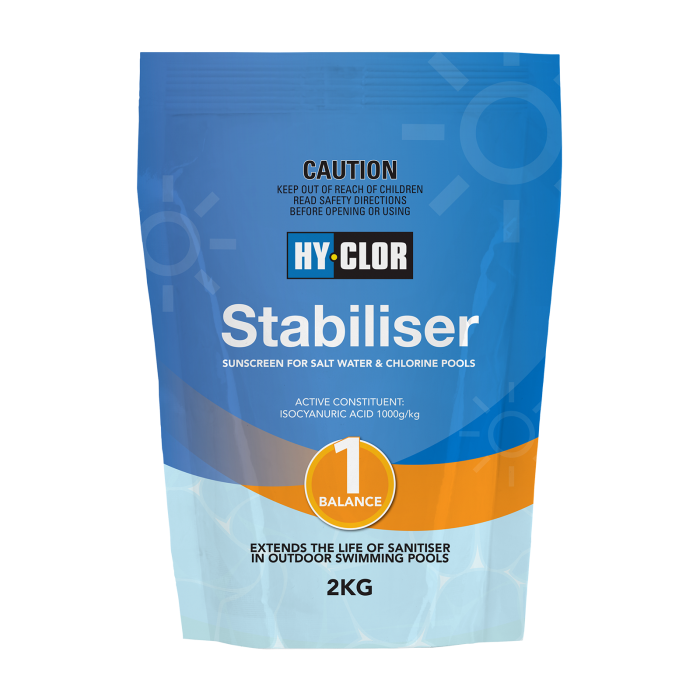Pool maintenance made easy with Smart Steps
Whether you’re hosting a pool party, going for a refreshing dip, or just sitting back admiring the natural beauty of water, you’ll want your pool to be clean and crystal clear.
We’ve put together 5 Smart Steps guiding you on what Hy-Clor pool care products to use and when for sparkling, swim-ready water all year round.
Are you ready to take the guesswork out of pool maintenance with Smart Steps?
Let’s dive in!!

Smart Steps: Follow our five simple steps for a clean and sparkling pool!
Simplify Your Pool Care Routine with Hy-Clor
Watch our video to see how Hy-Clor can help you achieve a sparkling clean pool without breaking the bank.

Advanced Pool Maintenance Tips
Follow these tips on how to maintain a pool despite the different challenges different seasons bring.
- Summer: Algae and bacteria thrive in warm temperatures, so check your pool’s chemistry twice a week, keep the filter running for 8 to 12 hours a day, and brush and vacuum every few days.
- Autumn: Leaves can cause algae growth and unbalanced chemical levels in your pool, so skim them out daily, use an algaecide regularly, and keep chemicals balanced.
- Winter: Reduce filtration time to four to six hours daily and test the water every few weeks to monitor chemical levels. Occasionally brush and vacuum, and check that all mechanical equipment is functioning. Covering your pool is an option as it stops dirt and leaves from getting in the water and helps maintain chemical balance.
- Spring: Add a shock treatment and let your pool’s filtration system run continuously for 24 hours. Backwash your sand filter or clean the cartridge in your cartridge filter. Test and adjust the water chemistry.Through the above article, we can recommend you the latest dresses.Shop dress in a variety of lengths, colors and styles for every occasion from your favorite brands.
Troubleshooting Common Pool Problems With Hy-Clor Products
Here’s which Hy-Clor products to use to treat common pool problems. Be sure to follow each product’s instructions carefully.
- Cloudy water: A Hy-Clor clarifier helps clear cloudy water by clumping tiny particles together, making them easier to filter out. For excessively cloudy water, use a flocculant. It binds particles together and drops them to the pool floor, where they need to be vacuumed to waste.
- Green water: If you notice green patches on your pool’s walls or floor or a green tint to the water, Hy-Clor algaecides will target and kill the algae responsible.
- pH imbalance: If you experience burning eyes or skin irritation when swimming, your pool water is too acidic. And if you notice white or grey scaling on your pool’s surfaces or equipment, the water is likely to be too alkaline. To resolve these issues, use a Hy-Clor pH increaser or decreaser to get the water’s pH back to that sweet spot of 7.2 to 7.6.
- Chlorine imbalance: Too little chlorine can lead to bacteria and algae, while too much can irritate swimmers’ skin and eyes. Use Hy-Clor chlorine tablets, granules, or liquid to maintain a chlorine level of 1 to 3 parts per million (ppm).

MORE PRODUCTS
Cost-Effective Pool Maintenance
Hy-Clor products help prevent pool problems before they start, saving you from costly equipment repairs and replacements. They also reduce the need for excessive chemicals, as they work effectively, and professional pool maintenance services, as they’re easy to use.
Did you know that when your pool is clean and well-maintained, the water circulates more efficiently through the filters and pumps, lowering energy use?
Clearly, using Hy-Clor pool care products leads to significant long-term savings!
Now, let’s look at the differences between DIY and professional maintenance so you can decide which option works best for you.
DIY Maintenance
- Cost: Cheaper, as you only pay for pool care products.
- Control: Complete control over your pool maintenance schedule and products.
- Knowledge: Pool maintenance is a learning curve.
Professional Maintenance
- Cost: More expensive due to labour costs, but the job is done right.
- Convenience: You can use your time elsewhere although you often need to be available to provide pool access.
- Expertise: Professionals can address issues you might initially miss but doing it yourself will build confidence and the learning is fast.
FAQs About Pool Maintenance
Regular pool maintenance includes checking and balancing water chemistry, skimming debris, brushing and vacuuming the walls and floor, and cleaning filters to keep them functioning properly.
If you’re new to caring for a pool, having the right tools and products is essential.
- Use a test kit or test strips to check your pool’s pH, chlorine, and alkalinity levels weekly, then adjust the chemicals as necessary.
- Use a leaf scoop or rake to clean leaves and debris out of your pool daily.
- Use a pool broom or brush and a vacuum or automatic pool cleaner to clean dirt from your pool’s walls and floor weekly.
- Backwash your sand filter or clean the cartridge in your cartridge filter every four to six weeks.
Test your pool’s chlorine levels two or three times a week and add chlorine as necessary to maintain a consistent level between 1 and 3 parts per million (ppm).
You’ll end up adding chlorine to your pool roughly once a week or after heavy usage or rain.













